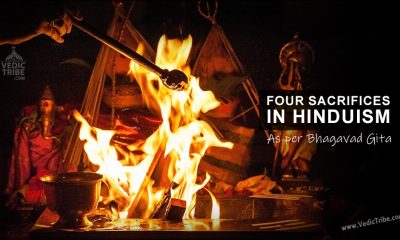Sikhism
Sri Guru Granth Sahib – The Living Guru
Published
5 years agoon
By
Vedic Tribe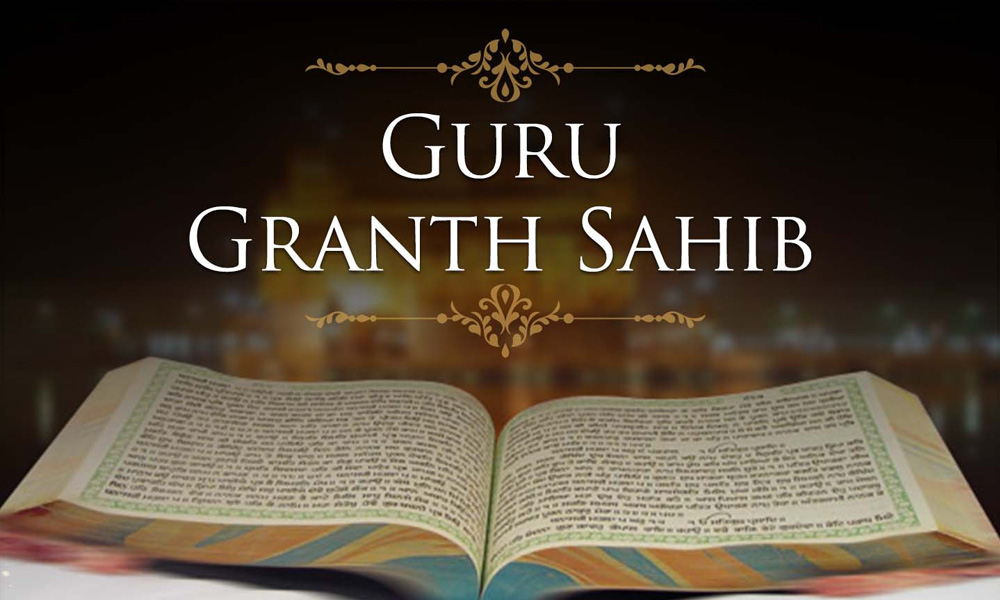
The Guru Granth Sahib contains the scriptures of the Sikhs. It is an anthology of prayers and hymns which contain the actual words and verses as uttered by the Sikh Gurus. Sikhs regard the Guru Granth Sahib as the living Guru. The Guru Granth Sahib, also known as the Adi Granth, consists of 1430 pages and has 5864 verses. Its contents are referred to as bani or gurbani. An individual hymn is a shabad.
The Granth was compiled by the fifth Sikh guru, Guru Arjan Dev ji. He undertook the enormous task of collecting, compiling, and scrutinizing the hymns and compositions of Guru Nanak and his predecessors. He decided to include not only the hymns of the Gurus but also that of other saints. At the invitation of the Guru, followers of different sects, both Hindu and Muslim, came to the Guru and recited the hymns of their teachers. Guru Arjan chose only those hymns which echoed sentiments he wanted to inculcate in his own community. After the selections were made, the Guru dictated the hymns to Bhai Gurdas ji, who wrote the Granth Sahib.
Having compiled the Granth, the Guru placed it in the newly- built Harmandir Sahib (Golden Temple) in Amritsar. The first parkash (opening ceremony) was performed in the Golden Temple by Guru Arjan on August 30, 1604. The Guru nominated Bhai Buddha as the custodian of the Granth Sahib. At this time, the Guru bowed before the collection, acknowledging the higher authority of the bani to that personal importance and significance which he possessed as Guru. After this time, he no longer sat at a level above the Granth Sahib, but below it. The Guru also instituted daily public worship at the temple where the Granth was recited all day long to the accompaniment of stringed musical instruments (kirtan).
With the passage of time, the original Granth Sahib passed on from Guru Arjan to Guru Hargobind and then to his grandson, Dhir Mal, who took permanent possession of it. To restore the Granth compiled by Guru Arjan to the Sikhs, Guru Gobind Singh ji sent some Sikhs to Dhir Mal’s descendants, who possessed the original Granth Sahib, and requested for its return. But they refused to part with it and asked the Guru to write his own Granth if he was a real Guru. Therefore, the second version of Guru Granth Sahib was prepared by Guru Gobind Singh in 1706. At Damdama Sahib, Guru Gobind Singh dictated the entire Granth Sahib from his memory to Bhai Mani Singh ji; the Granth Sahib was dictated word by word as it originally was. At this time, Guru Gobind Singh re-edited the Adi Granth to the form in which we find it today. The Guru removed some unauthenticated writings in the Granth and added four hymns in the beginning for evening prayers. Guru Gobind Singh also added several hymns from his father, Guru Tegh Bahadur. Otherwise, the Granth was left as it was before in the days of Guru Arjan.
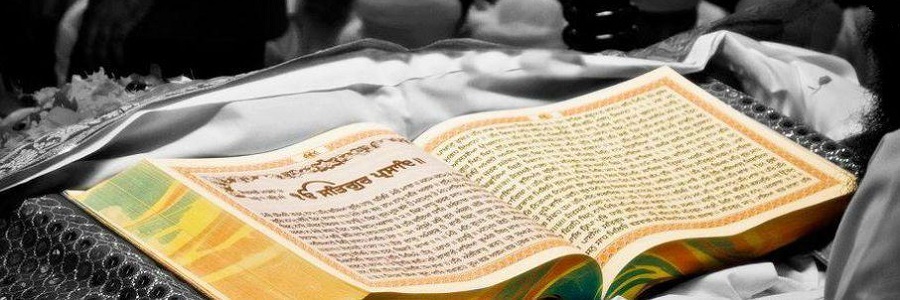
Several copies of this Granth were transcribed by hand by Baba Deep Singh ji at Damdama Sahib. It is believed that four copies of the Granth Sahib were prepared; the first one was sent to the Harimandir Sahib at Amritsar, the second to Anandpur, the third to Patna and the fourth was kept by Guru Gobind Singh at Nander.
Guru Gobind Singh ended the line of living Sikh Gurus by raising the Adi Granth to the status of a permanent Guru. Guru Gobind Singh ji transmitted Guru Nanak’s divine light into the divine Word and declared that after him, the next Guru would be Guru Granth Sahib. He commanded the Sikhs that it was to be revered as the body and spirit of the ten Gurus:
Agya bhai Akal ki tabhi chalayo Panth.
Sabh Sikhan ko hukam hai Guru manyo Granth.
Guru Granth Ji manyo pargat Guran ki deh.
Jo Prabhu ko milbo chahe khoj shabad mein le.
Raj karega Khalsa aqi rahei na koe,
Khwar hoe sabh milange bache sharan jo hoe.
Under orders of the Immortal Being, the Panth was created.
All Sikhs are enjoined to accept the Granth as their Guru.
Consider the Guru Granth as an embodiment of the Gurus.
Those who want to meet God, can find Him in its hymns.
The pure shall rule, and the impure will be no more,
Those separated will unite and all the devotees of the Guru shall be saved. (Ardas)
When the Guruship was passed on, Guru Granth Sahib like the Gurus became the embodiment of Divine Light. It should, therefore, be remembered very clearly that bowing before Guru Granth Sahib as Sikhs, is not bowing before a book, but it is a bowing before the Divine Light or Jot (Guru) which was passed on when the Guruship was conferred upon it. Respect and veneration for Guru Granth does not imply idol worship, but rather respect for a divine message, the ideas and ideals contained in the Sikh scripture. It is the source or a means to the worship of God through His Word, and not an object of worship in itself. Both the Gurus and the Book deserve the respect which they are accorded because of the bani which they express, the word of divine truth. Bhai Gurdas ji states that “the picture of the Guru is the gurbani” (Bhai Gurdas, Var 24, pauri 11).
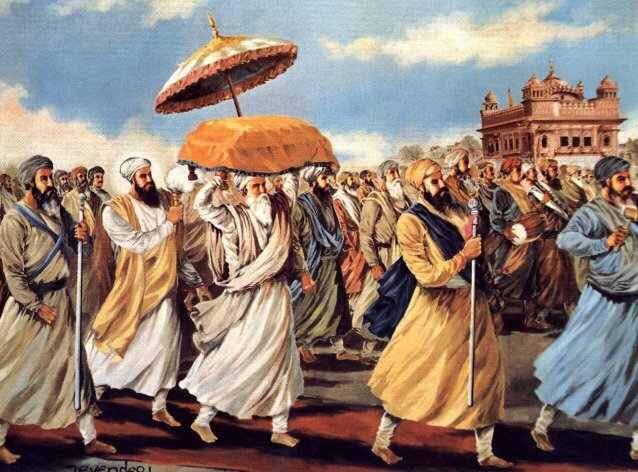
Revelation In The Guru Granth Sahib
Guru Granth Sahib is a remarkable storehouse of spiritual knowledge and teachings which does not preach any rites or rituals but stresses meditation on the Name of God; salvation can be obtained by means of regular, persistent and disciplined meditation. Most of the hymns are addressed to God and often describe the devotee’s condition: his aspirations and yearning, his agony in separation and his longing to be with the Lord. There are no mythological narratives, although God is described in anthropomorphic terms and the Gurus are not afraid to use the imagery of family relationships to describe the union of God and man.
The subject of Guru Granth Sahib is truth: how to become a ‘person of truth’, that is, an ideal person or gurmukh. As Guru Nanak states in the Mool Mantar, God is the Ultimate Truth and one has to cultivate those qualities which are associated with Him. Through its teachings, the Granth can enable men and women to lead a purposeful and rewarding life while being members of a society. It seeks universal peace and the good of all mankind. There is not a word in the Guru Granth Sahib that might be derogatory to any other belief or religion. The Guru Granth Sahib also stresses the democratic way of life and equality of all people. It teaches that we are karam yogis, that is we reap what we sow. The emphasis is on moral actions, noble living and working for the welfare of all people.
One of the most distinctive features of the Guru Granth Sahib is that it is the first religious book which contains the writings of persons belonging to different communities, castes, and diverse regions of the country. It incorporates and sanctifies the writings of holy men of different faith. Therefore, the language of the Granth is a mixture of almost all the Aryan languages current in India, yet it is written exclusively in Gurmukhi script. Guru Arjan Dev ji, unlike many other religious leaders, did not believe that there is one particular sacred language in the sense that man can pray to God only in that language.
The Granth Sahib contains 937 hymns of 36 Hindu saints, Muslim sufis and bards. The hymns of the these holy men cover a period of six centuries (from the 12th to the 17th century). Regardless of the author, this gurbani has an equal status as the hymns of the Gurus.
| Kabir | Muslim weaver | 292 hymns |
| Namdev | Calico printer from Maharashtra | 60 |
| Ravi Das | Shoe maker from Uttar Pradesh | 41 |
| Trilochan | Brahmin from Maharashtra | 4 |
| Dhanna | Cultivator from Rajasthan | 4 |
| Sain | Barber from Uttar Pradesh | 1 |
| Jaidev | Poet from Bengal | 2 |
| Pipa | King from Uttar Pradesh | 1 |
| Sur Das | Blind poet | 2 |
| Baba Farid | Muslim saint from Punjab | 134 |
| Parmanand | Maharashtra | 1 |
| Sadhna | Butcher from Sindh | 1 |
| Beni | 3 | |
| Ramanand | Uttar Pradesh | 1 |
| Bhikhan | Sufi saint from Uttar Pradesh | 2 |
There are also some hymns from Sikhs during the time of the Gurus, including those from Baba Mardana ji, Baba Sunder ji, Sata Doom, and Rai Balwand. In addition, the Granth Sahib includes some bani from eleven bards (bhats) who came to the court of Guru Arjan in 1580. They were men of wisdom and were much impressed by the personality and the work of the Guru. Their names are Kalashar, Jalap, Kirat, Bhikha, Sal, Mathura, Bal, Bhal, Nal, Gayand, and Harbans. Yet, overall, the majority of bani in the Guru Granth Sahib contains the hymns of the Gurus:
| Guru Nanak | 974 hymns |
| Guru Angad Dev | 62 |
| Guru Amar Das | 907 |
| Guru Ram Das | 679 |
| Guru Arjan Dev | 2218 |
| Guru Tegh Bahadur | 115 |
| Guru Gobind Singh | 1 |
Most of the introductory bani in the Granth Sahib is written by the Sikh Gurus. The Guru Granth Sahib starts with Guru Nanak’s composition, Mool Mantar followed by Japji, Rehras (the morning and evening prayer respectively) and Kirtan Sohila, the night prayer. This introductory gurbani occupies the first thirteen pages of the Guru Granth Sahib.
Jap Ji, also called Guru Mantar, was written by Guru Nanak. It occupies about 9 pages and consists of 40 sloks, called pauries of irregular length. The mode of composition implies the presence of a questionnaire and an answer. Jap Ji is followed by Sodar Rehras, another composition by Guru Nanak, although later on additions were made to it by Guru Ram Das and Guru Arjan Dev. Sodar is the yearning of the soul for the door of the house of God. Kirtan Sohila follows Sodar and occupies a little over one page. It was also composed by Guru Nanak but has additions by Guru Ram Das and Arjan Dev.
The next portion of the Granth is divided into thirty one sections each according to a particular raga. This portion occupies 1154 pages.
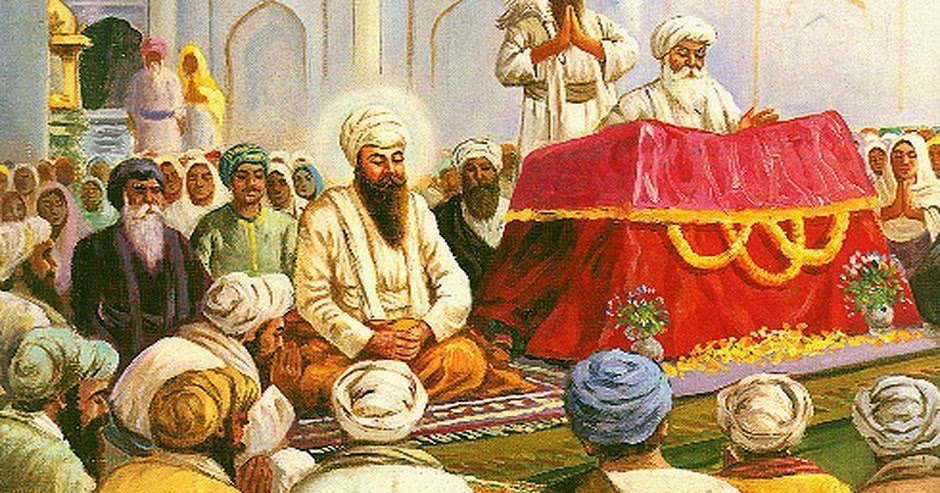
Usage of Ragas
The Gurus considered divine worship through music the best means of attaining a state of bliss. Therefore, each of the hymns in the Guru Granth Sahib is noted with the melody and rhythm (raga) to which it is to be sung or read. There are 31 musical measures (ragas) in the Guru Granth Sahib. The selecting of ragas was carefully made by the Guru. Generally speaking, ragas are composed to suit various moods. Some are appropriate to the morning, others to the evening, some to joy, others to grief. Guru Arjan indicated that faith should produce a balanced outlook, tempering both happiness and sadness. Therefore, the Guru omitted those that aroused passions of any kind. Likewise, certain ragas were rejected for their melancholy.
The basic concept behind the hymns is that kirtan (sacred music), when sung or listened to with devotion and undivided attention, can link the individual’s consciousness with God. A mind may become stable and enjoy the peace of His divine presence, as listening to the hymns can exert a powerful influence on the mind and help to establish its communion with God.
Role of the Guru Granth Sahib in Sikh Life
In all gurdwaras and many Sikh homes, the Granth is read every day. No Sikh ceremony is regarded as complete unless it is performed in the presence of the Guru Granth Sahib. On a daily basis, Sikhs receive a hukam or divine order in the form of a hymn from the Guru Granth Sahib, either in a Gurdwara or at home. The hukam is the first hymn of the holy book from the left hand page when it is opened at random. Similarly, at the end of a service, after the ardas, the Adi Granth is opened at random and a portion is read. Many Sikhs do this daily, regarding the verses as words from God which they will find helpful during the day. This is called vak lao, taking advice.
On special occasions, the Granth Sahib is recited non-stop from cover to cover by a string of readers. This continuous reading of the Guru Granth Sahib is known as an akhand path. It is regarded as the highest and the noblest ceremony in the Sikh religion, and can be performed on any important occasion. It requires nearly 48 hours to complete the continuous reading. According to Sikh history, the first akhand path was performed by Guru Hargobind, the sixth Guru, after the death of his wife, Mata Damodri ji. An akhand path was also performed by Baba Deep Singh ji when he pledged before God at Damdama Sahib to sacrifice his life for the protection of human rights.
A saptahak path is a daily reading of Guru Granth Sahib to be completed in seven days. It is sometimes undertaken in private homes as a mark of supplication on special occasions. A sehaj path is a reading of Guru Granth Sahib that can be completed at any length of period beyond seven days.
Guru Granth Sahib ji remains as a permanent unchangeable guide for all Sikhs as a living Guru or Teacher. It is a representation of the undaunted strength of the Sikh community. Guru Arjan Dev preferred a martyr’s death to saving his life through making alterations in the hymns as required by Emperor Jahangir. Any Sikh can open the pages of the Guru Granth Sahib and find strength and guidance through His Word: “The Guru is now always with me” (Guru Arjan, Rag Asa)
You may like
Fesitvals
Significance of Baisakhi / Vaisakhi
Published
5 years agoon
April 13, 2021By
Vedic Tribe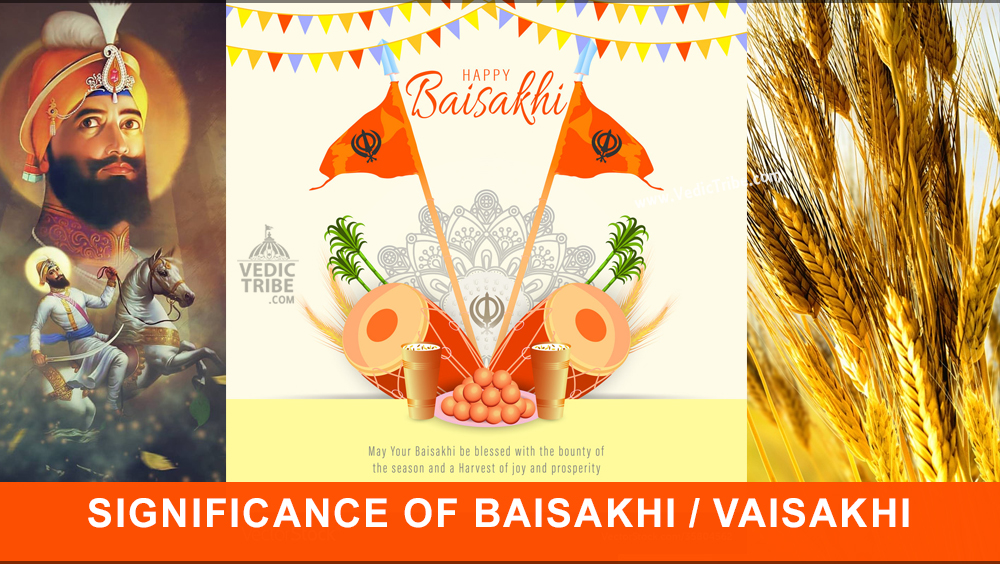
Baiskhi is also spelled ‘Vaisakhi’, and is a vibrant Festival considered to be an extremely important festival in India. It is celebrated all over India under different names and rituals.
Astrological Significance of Baisakhi
The festival of Baisakhi falls on April 13 every year and April 14 once in every 36 years. Change in date is because of the fact that date of Baisakhi is reckoned according to the solar calendar. Astrologically, the date of Baisakhi is significant as marks sun’s entry into Mesh Rashi.
For this very reason, many people also know Baisakhi as Mesha Sankranti. The auspicious date of Baisakhi is celebrated all over India under different names and rituals. It is celebrated as ‘Rongali Bihu’ in Assam, ‘Naba Barsha’ in Bengal, ‘Puthandu’ in Tamil Nadu, ‘Pooram Vishu’ in Kerala and ‘Vaishakha’ in the state of Bihar.
Significance of Baisakhi for Farmers
For the agriculturally rich state of Punjab and Haryana, Baisakhi marks the time for harvest of Rabi (winter) crops and is therefore extremely significant for the farmers. Baisakhi Festival is also celebrated as a Thanksgiving Day festival in these states. After waking up early and dressing themselves in new clothes, farmers visit temples and gurdwaras to express gratitude to God for the good harvest and seek blessing for ensuing agriculture season. Farmers also celebrate Baisakhi by performing energetic bhangra and gidda dance and participating in Baisakhi Fairs.
Significance of Baisakhi in Sikhism
Baisakhi is of major importance for the people following Sikh faith. As it was on a Baisakhi Day, in the year 1699 that the Tenth Guru of Sikhs, Guru Gobind Singh founded Khalsa Panth or the Order of Pure Ones and gave a unique identity to Sikhs. On the same day the guru administered amrit (nectar) to his first batch of five disciples making them Singhs, a martial community. By doing so, he eliminated the differences of high and low and established that all human beings were equal.
Baisakhi is New Year’s Day in Punjab. It falls on the month of Vaisakh. This festival marks the ripening of the Rabi harvest. The day coincides with the solar equinox on the13th of April. It was on this day that the tenth Sikh Guru, Guru Gobind Singh, founded the Khalsa (the Sikh brotherhood) in 1699. For Sikhs, this is as a collective birthday. It is celebrated on April 13, though once in 36 years it occurs on 14th April.
Sikhs celebrate Baisakhi by participating in special prayer meetings organized at gurdwaras. They also carry out joyful Baisakhi processions to mark the day.
Significance of Baisakhi in Other Religions
The day of Baisakhi is of significance for the Hindus as it was on this day in 1875 that Swami Dayanand Saraswati founded the Arya Samaj – a reformed sect of Hindus who are devoted to the Vedas for spiritual guidance and have discarded idol worship. Besides, Baisakhi day is of relevance for the Buddhists as Gautama Buddha attained enlightenment and Nirvana on this auspicious day.
In Kerala, the festival is called ‘Vishu’. It includes fireworks, shopping for new clothes and interesting displays called ‘Vishu Kani’. These are arrangements of flowers, grains, fruits, cloth, gold, and money are viewed early in the morning, to ensure a year of prosperity.
In Assam, the festival is called Bohag Bihu, and the community organizes massive feasts, music and dancing. Bengalis mark it as new years day or ‘Naba Varsha’ or Pohela Boishakh in Bengal, Assam and Tripura.
Puthandu (Tamil New Year) in Tamil Nadu. Whatever the history says, today Baisakhi is celebrated with all pomp and show in almost all parts of the country.
Sikhism
Original Sikh Flags Had Hindu Deities not Khanda – Part 1
Published
5 years agoon
January 8, 2021By
Vedic Tribe
All that whitewashing on their part of the Nishaan Sahib being a purely ‘Sikh’ flag & how the sacred Khanda, itself has nothing to do with Hindu Dharma – this misinformation gives the ignorant Sikhs of today a wrong sense of self pride without any one of them ever learning the truth behind how the flag came about in the first place.
Neo-Sikhs of the Singh Sabha managed to brush all the Hindu traditions under the carpet far away from the eyes of the future generations, though overlooking the main fact that Saffron is traditionally a Sanatan Dharmic colour. Our flags hoisted above sacred shrines such as Hindu mandirs & Gurudwaras symbolise the sanctity of our ancient heritage of Hinduism. Our Sadhus, Gurus, saints, vairagis etc all wear traditional colours of Saffron. They even wear seli topis & turbans & have long hair as well as beards.
This is not just the mark of a Sikh, but traditionally, a Hindu mark. Rajput warriors & Kings were the first ones to keep unshorn hair & long beards during the 15th century onwards. Before them, the Hindu Rishis & Sadhus, Siddhas & Yogis all kept unshorn hair & wore traditional turbans. But the stooges of Tat Khalsa & the Sikhi Taliban brigade have painted a very false picture to all the people of Punjab.
Ignorant of the fact that the ‘Sikh’ flag, that was carried on many a battlefield by the Nihangs & Khalsa armies, including that of Maharaja Ranjit Singhji, usually had a motif of Hindu Gods of war such as Lord Shiva, Goddess Durga, Goddess Kaumari, Goddess Varahi, Hanuman etc, the Singh Sabhias with the Talibanised Sikhs have falsely continued with their propagation of Nishaan Sahib as the original ‘Sikh’ flag during the time of the Gurus. They even deny any connections with the Hindu weaponry of Khadga ( 2 edged sword) & the Chakra ( Lord Vishnu weapon) & simply play them down as being from a different tradition.
THIS IS A BLATANT FRAUD!
Recently many questions are being raised concerning the several controversies that surround the re-writing, re-editing of Sikh history as well as the Shri Adi Granth – whether the Kartarpur Bir itself is authentic or not. However, this is another topic I will go into later on.
Back to the flag with motifs of Hindu Devatas which every Sikh & Talibanised Neo-Sikh must know of & acknowledge the fact that YES, Sikhs were Hindus of the Sanatan tradition of India before the British missionary satans ruined Punjab & divided its people who all acknowledged themselves as Hindus prior to the white guy setting foot on Indian soil. Khalsa warriors used to carry these flags onto all the battlefields when fighting the Islamic tyrants & British imperialists & it is my pleasure to present an entire post on images of great history that the Tat Khalsa stooges have kept away from all of us. Let us take a closer look at the history behind the Khanda, its sacred symbols of the Nishaan Sahib which was later on made the emblem of the Sikh flag.
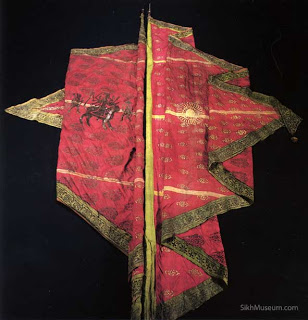
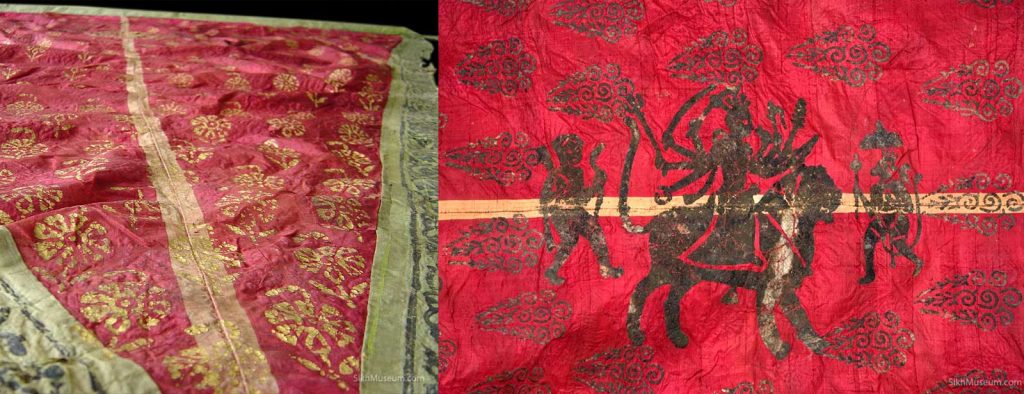
Khalsa Armies with Banner displaying motif of Goddess Varahi, the Hindu Goddess of War.
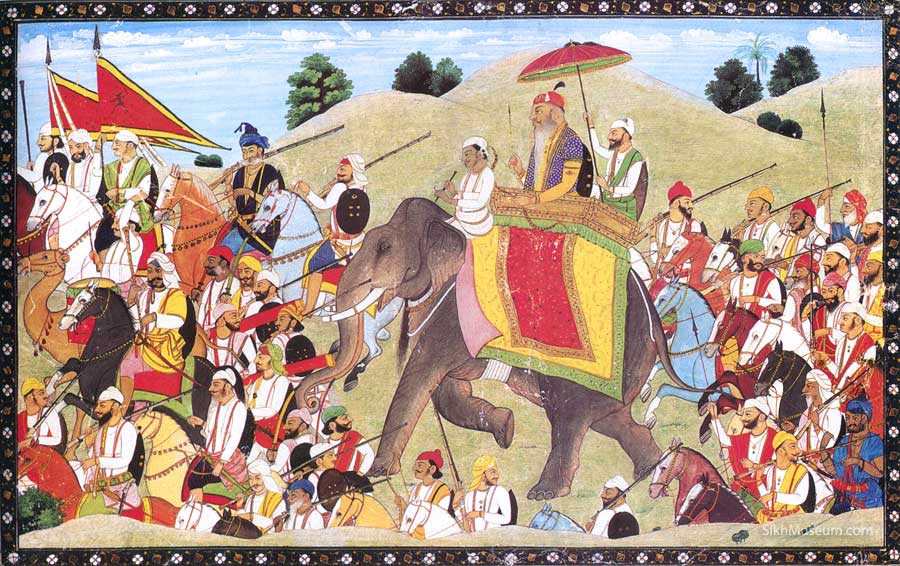
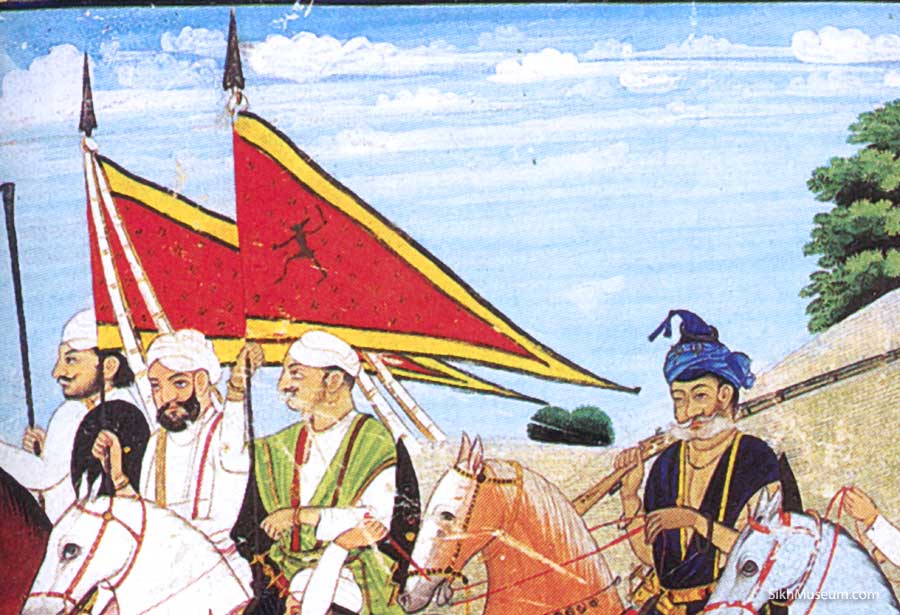
Khalsa Armies with Banner displaying motif of Goddess Varahi ,the Hindu Goddess of War.
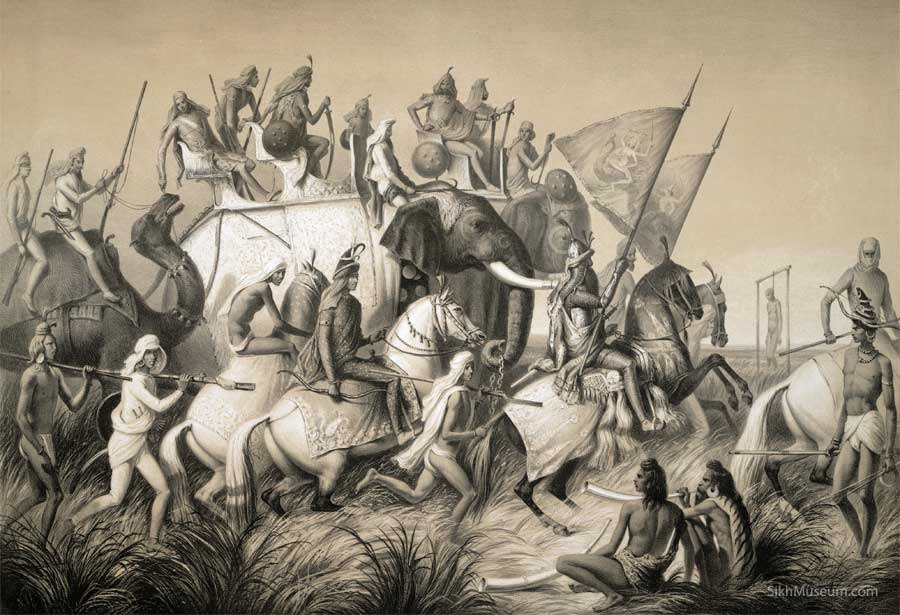
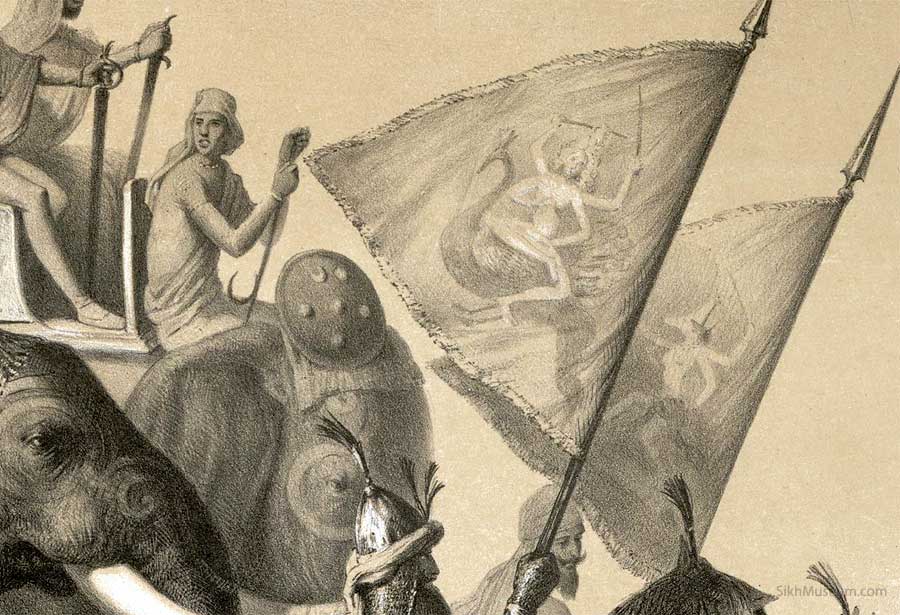
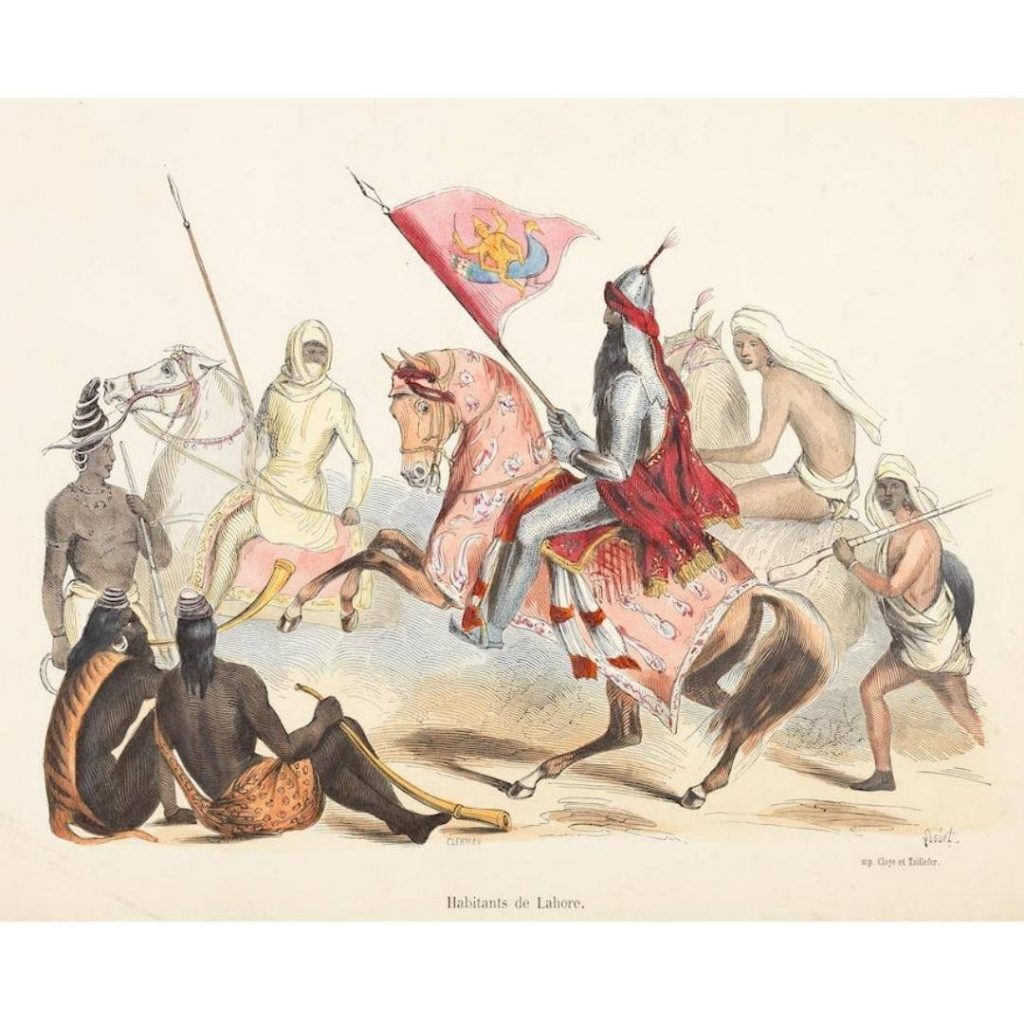
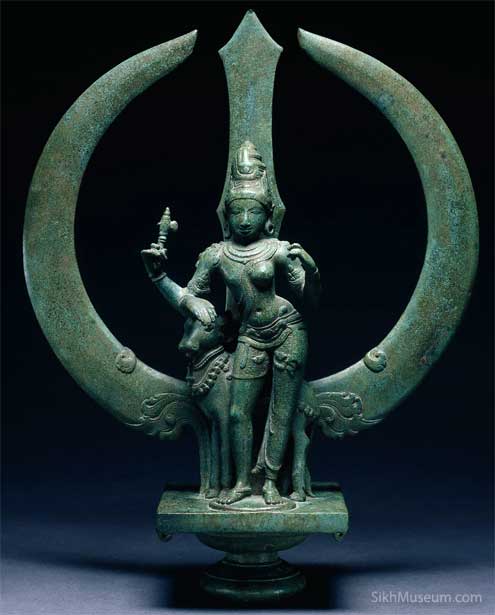
As explained by the Buddha Dal which is the oldest faction of the Nihang sect :
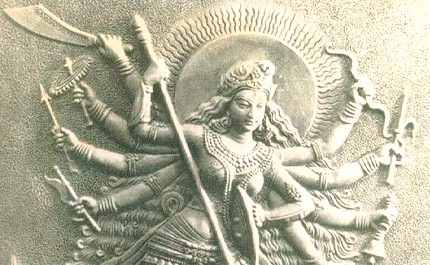
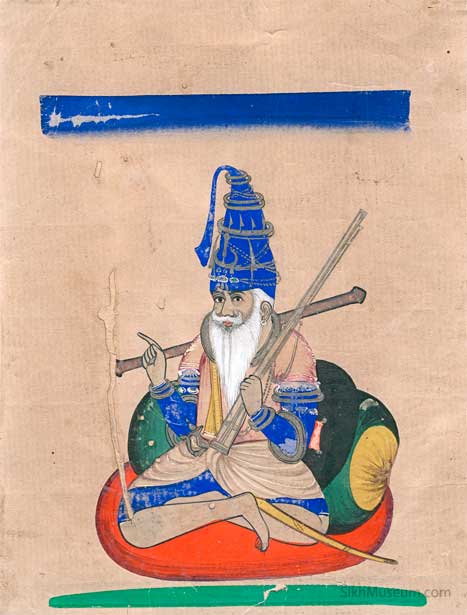
Nihang Chieftain – ca. 19th century, paint on paper, Gurmit Singh & Satnam Singh Collection
TO BE CONTINUED…
Hinduism
Brahmins who Sacrificed for Sikhs and Sikh Gurus
Published
5 years agoon
December 13, 2020By
Vedic Tribe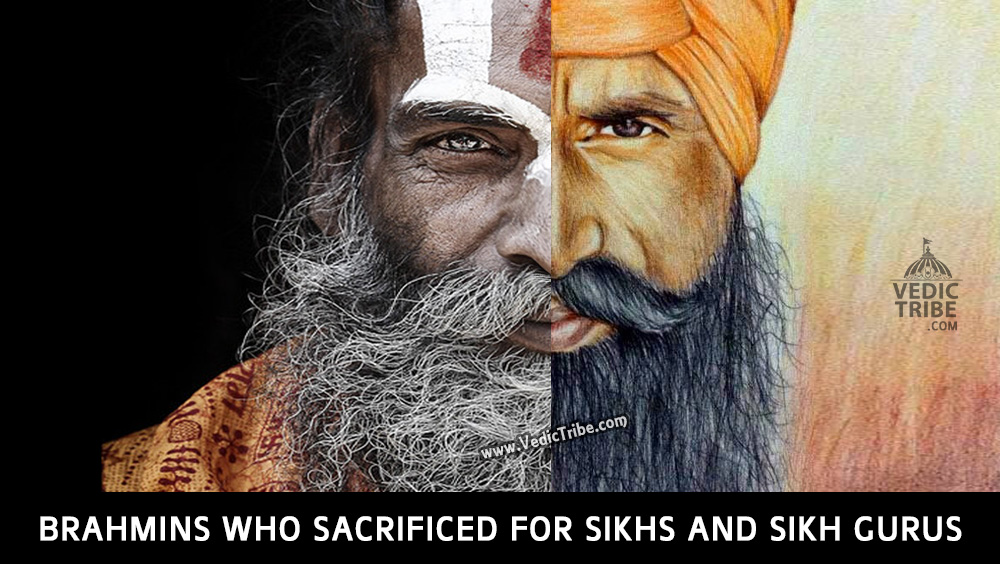
Read in Hindi below English version
Usually people from the Sikh society and the separatist Khalistani Jatts use very condemnable hateful words towards Brahmins. For a mistake of a Brahmin named Gangu, they blame the whole Brahmin society, call them coward and traitors. But these Pakistani supporting and brainwashed people do not know that the most soldiers in the army of Sikh Gurus were from the Brahmin society.
1. Pandit Praga Das Ji
2. Pandit Peda Ji
Pandit Peda Das ji was also the main ally of Guru Arjun Dev ji and he was the chief commander of the army of Sikh Guru Hargovind Singh ji. He took part in all the battles alongside with Guru Ji and finally got martyred in the battle of Amritsar.
3. Pandit Mukunda Ram Ji
4. Pandit Jattu Das Ji
5. Pandit Singha Purohit Ji
6. Pandit Malik G Purohit
7. Pandit Lal Chand Ji
8. Pandit’s Kripa Ram ji
9. Pandit Sanmukhi Ji
10. Pandit Chopad Rai Ji
11. Pandit Mathura ji
12. Pandit Kirat ji
13. Pandit Balu ji
14. Pandit Sati Das ji
15. Pandit Mati Das Ji
16. Bajirao Peshwa
ब्राह्मणों द्वारा सिक्खों के लिए दिए गए बलिदान :-
1. पंडित प्रागा दास जी
2. पंडित पेड़ा जी
3. पंडित मुकुंदा राम जी
4. पंडित जट्टू दास जी
5 .पंडित सिंघा पुरोहित जी
6. पण्डित मालिक जी पुरोहित
7. पंडित लाल चंद जी
8. पंडित किरपा राम जी
9. पंडित सनमुखी जी
10. पंडित चोपड़ राय जी
11. पण्डित मथुरा जी
12. पण्डित किरत जी
13. पण्डित बालू जी
14. पण्डित सती दास जी
15. पण्डित मति दास जी
16. बाजीराव पेश्वा
Follow us on Facebook
Follow us on Twitter
Latest


Seven Vows and Steps (pheras) of Hindu Wedding explained
Views: 9,199 Indian marriages are well renowned around the world for all the rituals and events forming part of the...


Sari or Saree is symbol of Indian feminism and culture
Views: 7,422 One of the most sensual attires of a woman in India is undoubtedly the sari. It is a...


Atithi Devo Bhava meaning in Hinduism and India
Views: 7,190 Atithi Devo Bhava, an ancient line taken from the Hindu scriptures and was originally coined to depict a visiting person whose...


Sanskrit Is More Than Just A Method To Communicate
Views: 5,390 -By Ojaswita Krishnaa Chaturvedi anskrit is the language of ancient India, the earliest compilation of sound, syllables and...


Significance of Baisakhi / Vaisakhi
Views: 6,613 Baiskhi is also spelled ‘Vaisakhi’, and is a vibrant Festival considered to be an extremely important festival in...


Navaratri: The Nine Divine Nights of Maa Durga!
Views: 7,719 – Shri Gyan Rajhans Navratri or the nine holy days are auspicious days of the lunar calendar according...


History of Vastu Shastra
Views: 10,934 Vastu Shastra (or short just Vastu) is the Indian science of space and architecture and how we may...


Significance of Bilva Leaf – Why is it dear to Lord shiva?
Views: 10,565 – Arun Gopinath Hindus believe that the knowledge of medicinal plants is older than history itself, that it...


Concept of Time and Creation (‘Brahma Srishti’) in Padma Purana
Views: 10,847 Pulastya Maha Muni affirmed to Bhishma that Brahma was Narayana Himself and that in reality he was Eternal....


Karma Yoga – Yog Through Selfless Actions
Views: 9,721 Karma Yoga is Meditation in Action: “Karma” means action and “yoga” means loving unity of our mind with...


